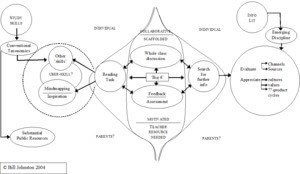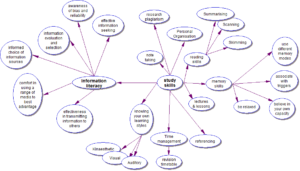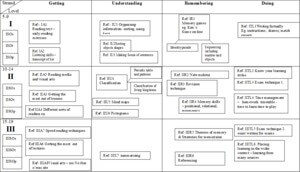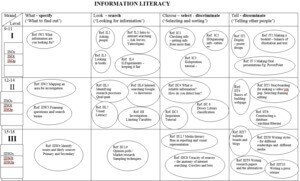Report on Project for LT Scotland
[divide margin_top=”10″ margin_bottom=”10″ color=”#a0a0a0″]
Abstract
The project for LT Scotland commenced in May 2004 and my involvement came to an end in about June 2005, when the program was at Beta testing stage, and prior overseas commitments meant that I was unable to consolidate my earlier desk research with some work in the field.
The commission, which was carried out under the aegis of Cambridge Training & Development (CTAD – a member of Tribal Group), was to provide a series of logically related interactive multi-media learning objects (LOs) on Information Literacy and Study Skills for the LTS on-line learning content repository. My task was to work with colleagues at Strathclyde University and LTS to come up with a rationale for the work and I then had to commission half a dozen, or so, writers who scripted the LOs prior to going into production at the CTAD workshop. The paper came out of a series of meetings with colleagues from Strathclyde, some desk research of my own coupled with several discussions with the client to ascertain their real needs.
Author: Michael Lightfoot Publication Date: 2006
There are clear indicators within the Scottish educational context which illustrate the strong commitment of the Scottish Executive towards achieving excellence in schools, and for creating and education culture which is relevant for the citizens of tomorrow.
The Future of Teaching and Learning programme, with initiatives such as Design for Learning in the 21st Century School, and the Open, Flexible, Distance Learning Programme are clear examples of the sort of forward thinking which is prevalent within the Executive.
Not only are resources being devoted to the development of new teaching and learning environments, but penetrating questions are being framed to challenge many preconceptions about teaching and learning. The manner in which the National Grid for Learning is being populated in Scotland, with on-line teaching and learning resources commissioned through LT Scotland, supports the view that new paradigms for teaching and learning, which transcend traditional notions of the custodial classroom, are being developed.
Great stress is placed upon the importance of young people developing a range of skills in order to become independent learners, who are capable of directing their own study and who can critically evaluate information from many sources. Few commentators would disagree that the classroom of tomorrow will be very different from that of today. There is something of an inbuilt assumption that much learning will take place through interaction with information and communication technology (ICT) and that this will profoundly alter the nature of the teacher / learner relationship. Within this context, where young learners have a world of information at their fingertips, the role of the teachers is increasingly seen as the “guide on the side” rather than the “sage on the stage”.
The transition towards these new models of teaching and learning must be carefully managed if learning is not to become a superficial mechanistic process mediated through computers. Learners’ skills in critical thinking must be developed and their skills in personal organisation as well as information retrieval and interpretation have to be nurtured.
Conscious of this transitional phase in the development of e-Learning amongst school-aged learners, the approach which the developers have adopted, in the design of the learning objects created to support the development of Information Literacy and Study Skills, is one of flexibility so that the learning objects can be used as self-standing elements for self study, as well as vehicles for collaborative work or as resources which teachers can use for a whole-class focus.
Since raison d’etre of these learning objects is to develop the very skills which learners will need to apply across the curriculum, great care has been taken to design a clear process model which will assist the learners in the development of their own understanding and application of electronic media to facilitate their learning across the curriculum.
Whilst there is clearly a considerable overlap between the areas of Information Literacy and Study Skills, there also remain important differences which underpin their existence as discrete areas for academic discourse and for the development of learning materials
The development of effective study skills has become an increasingly important feature of the education landscape as the trend towards self-directed independent learning has gathered pace. Whereas effective research skills and the development of students’ ability to organise their time effectively was once the preserve of those who were embarking upon a course of study at higher education, over the past twenty years these skills have become an increasingly important part of the repertory of skills expected of students of school age. Over this time, the curricula in both the sciences and the humanities have developed in such a way as to require students to undertake more investigative work and spend more of their time researching, taking part in collaborative studies and in conducting self-directed projects.
Nonetheless, much of the available literature relating to study skills has been concentrated on the needs of learners approaching higher education and the study skills for younger students have largely been focused on revision, knowledge reinforcement and preparation for public examinations. The emphasis by central government upon the summative testing of knowledge acquisition has been a major driver in this trend. This, in turn, has brought about the development of large amount of student-focused material aimed at revision and knowledge reinforcement. Much of this has been on-line, the most ubiquitous of which is the highly successful BBC Bitesize revision programs.
In recognition of the fact that, arguably, the best developed and most populated of all aspects of study skills, certainly for school-age students, is the one which is centred upon revision and examination preparation, the design and distribution of learning objects for this project has endeavoured to broaden the breadth and scope of study skills. The approach adopted embraces the need to provide materials to develop the learners’ acquisition and processing of received wisdom as well as those processes associated with recall and synthesis.
The decisions which have shaped this project have been informed by the current academic discourse relating to study skills, learning about learning, and learning how to learn. Howard Gardner’s theories of multiple intelligences and the subsequent research about learning styles – visual, kinaesthetic and auditory – have been highly influential in this regard.
Study skills, then, inhabit reasonably familiar territory for most education practitioners. By contrast, the concept of information literacy is relatively new to many teachers, and there are currently many misconceptions within the profession.
Although the juxtaposition of the common words information and literacy were first linked more the 30 years ago by Paul Zurkowski, it is the emergence of the information society, characterised by the rapid growth of available information and accompanying changes in the technology used to generate, disseminate, gain access to and manage that information which has really enabled the concept to take root.
Some would hold that information literacy is simply something to do with being able to use computers in a literate way, whilst others, such as Dr Jamie McKenzie, take a far more radical view and believe that, in the education context, it is time that the term IT (information technology) is replaced completely by IL (information literacy) to contrast the mere movement of information through computer networks (which is a lower order activity) with the more important and significant human endeavour of interpreting information in order to guide decisions, solve problems, and steer a steady course through uncertain and complex futures.
The charts overleaf go some way towards this project’s exemplification of the relationship between Study Skills and Information Literacy. The interpretation of Figure 1) sees both Information Literacy and Study Skills both contributing to a cognitive process that takes place in the minds of the learners. Figure 2) takes a more pragmatic approach, itemising some key elements in both Study Skills and Information Literacy.
The Figure 2) implies that information literacy could be seen as an aspect of study skills, and indeed, in one sense it is. However, study skills have attached to them irredeemably school-like overtones, whereas information literacy should truly be seen in a much wider context. It is no coincidence that the development of the concept of lifelong learning has taken place hand in hand with the increasing acceptance of information literacy being an essential skill which all citizens should possess. The working definition of an information literate person, adopted by the 2003 UNESCO meeting in Prague, is a useful one:
“People are information literate who know when they need information, and are then able to identify, locate, evaluate, organise and effectively use the information to address and resolve personal, job-related or broad social issues and problems”
There are several models in circulation which serve to reformulate information literacy into bite size chunks. One which is widely used , certainly in the USA, is the Big6 ( referred to in Figure 1) developed by Mike Eisenberg and Bob Berkowitz in which their six steps are as follows:
1. Task Definition
2. Information Seeking Strategies
3. Location and Access
4. Use of Information
5. Synthesis
6. Evaluation
The authors contend that people go through these Big6 stages—consciously or not—when they seek or apply information to solve a problem or make a decision.
Figure 1 (Click on image to enlarge.)
Figure 2 (Click on image to enlarge.)
Another formulation on this process model of information handling has been made by the Scottish academic James Herring. He refers to his model as PLUS; the discrete steps in his model being: Purpose, Location, Use and Self-evaluation.
Acknowledging current thinking, and in recognition of the importance of the WHOLE cycle of information acquisition // sorting // discriminating // and processing followed by some sort of synthesis and eventual output in new and meaningful ways, the distribution of the learning objects throughout both the Study Skills and Information Literacy components have been conceived within a straightforward input – process – output model. The approach is widely accepted in the design of instructional materials, particularly those which are to be mediated through information and communication technology. It is an essentially constructivist model within which it is maintained that a learner creates meaning from new information only when they are able to place it within their own experiences and cognitive framework.
In its essence, therefore, it is imperative that from the very earliest drafting of the content of each individual learning object, authors and originators of learning objects and materials are considering the ways in which the learner will be challenged and questioned by the content of the learning object so that the experience is a highly interactive one. This intrinsic interactivity makes best use of the medium of ICT through which this learning is being delivered.
One challenge in deciding upon the nature of the content and the distribution of the various learning objects for both Information Literacy and Study Skills has been the breadth of the age range for whom these resources are to be available. The choices which have been made are based upon the relative abundance or scarcity of materials in the different age ranges coupled with an assessment of the accessibility of the materials to the learners based upon a general interpretation of Piaget’s characterisation of age-related cognitive development.
As a result of this, the majority of the learning objects under development are aimed at the upper primary and lower secondary students, with an indicative age range of about 10 – 14 years. A great deal of material is already available on the internet for the 15+ age range, so the main focus here is on providing the learners with more advanced skills. This will enable them to become more discriminating in their use of information from many different sources, and better able to organise and synthesise this information. They will do this through better knowledge of their own learning styles and a better understanding of conventions for exchanging information within online communities, both academic and otherwise.
Figures 3) and 4) overleaf provide a summary of the learning objects which are currently under development. Every learning object represents a free-standing piece of learning with its own clear rationale. There are, however, indicative pathways moving across horizontally which could take a learner through the complete journey from acquisition through understanding, and recall to synthesis and transmission.
Figure 3 (Click on image to enlarge.)
Figure 4 (Click on image to enlarge.)
The vertical strands represent a progression route following a particular process theme, gathering in complexity and intellectual demand from the youngest to the oldest target age range.
In order to provide the different potential readerships of Students, Teachers and Parents with an idea of the rationale behind the learning objects, and a process which could helpfully link them together, in each of the three age bands for both Information Literacy and for Study Skills, there will be additional objects which give a synoptic overview of the objects in a given horizontal set.
These synoptic objects will describe the process of acquisition – processing – synthesis and provide suggested routes through several learning objects for particular purposes. An appropriate route through the objects can then be suggested or specified by a teacher, with scope for differentiation to more basic or more complex activities for each of the learning object themes in both Study Skills and Information Literacy.
The guides for parents will include questions for the parents to ask of their sons and daughters in order to clarify how these learning objects contribute to their studies and they will be shown how the need for all citizens to have at least basic levels of Information Literacy in order for them to be able to benefit from the new information age which is dawning. Parents will be helped to identify the impact which the information age will have upon all members of society regardless of their competence and skill in the use of computers.
Within the wide definition of the term “information” the project has embraced important sub-categories, such as visual literacy and media literacy, to emphasise the fact that, whilst computers and the internet are important mediators of information, there are other more widely available information sources such as photographs, TV , film and newspapers. A facility to critically interpret these information sources is an essential skill for people living in the information age.
Some of the learning objects in the Information Literacy component deal specifically with the process of seeking and searching for information on the internet whilst others deal with the ways in which the internet can be used for sharing information widely with others by way for example of bulletin boards or weblogs. In this way, users will be enabled to develop their skills as effective navigators of information as well as being able to formulate their own information for transmission to others in effective ways.
Similarly for the learning objects in Study Skills deal with the whole cycle of study from the acquisition and the processing of new knowledge to the synthesis and output of the knowledge in appropriate ways for particular audiences and readerships.
The design and distribution of the learning objects have been undertaken in such a way so as to create objects which are self-standing and independent in their own right, but which are also complementary to other objects in both the Study Skills and Information Literacy sets of objects. The objects have been designed with extension activities for the learners to undertake both singly or collaboratively with others with whom they may be sharing the ICT facilities. Teachers may also wish to use the some of the objects as resources for whole class teaching, in order to exemplify a particular aspect of either Information Technology or Study Skills.
Approximately 60 learning objects are being created to populate the Study Skills and Information Literacy on-line curricula; their titles and consequent learning objectives represent the bare skeleton of what the editors believe is necessary to adequately cover this complex area of metacognition, or learning about learning. Many examples have been taken from subjects on the Scottish curriculum in order to illustrate and inform the content of the learning objects, but because of the great breadth of the curriculum to be covered, the approach adopted is often rather generic. As the concept of information literacy becomes more established within the education community in Scotland, an increasing demand will inevitably arise for the development of further resources, perhaps with an increasing degree of subject specificity as the on-line learning community matures and grows over the next few years.
These learning objects will provide a solid foundation upon which to devise and construct a wide range of new resources in the future.
[/two_third_last]
[divide margin_top=”10″ margin_bottom=”10″ color=”#a0a0a0″]
References & Contacts
None available
[divide margin_top=”10″ margin_bottom=”10″ color=”#a0a0a0″]
[review]
[/s2If]




